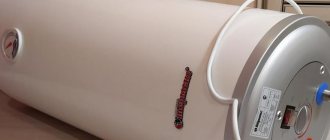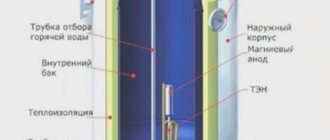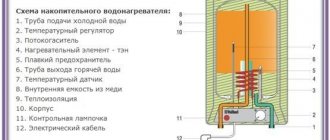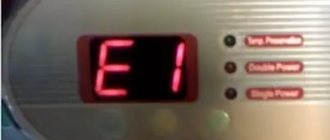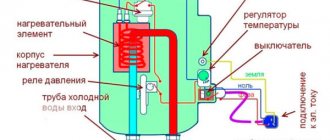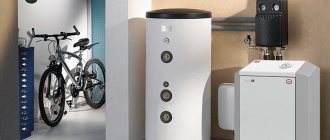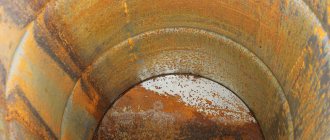For city apartments and country houses, the problem of uninterrupted supply of hot water is not always solved with the help of centralized water supply. For this purpose, special water heaters are used, the power of which and design may vary. Among the equipment offered on the market, there are various device options that differ not only in the power of the water heater, but also in the principle of heating water.
But what is the difference between a boiler and a water heater?
Which one can be used for installation in a city apartment, and which one is suitable for providing hot water to a large system and a private house as a whole? Let us answer this question by considering the individual characteristics and features of such equipment.
Features of indirect heating storage boiler
What is the difference between a boiler and a water heater? They are similar in many ways, but there are some differences. If the coolant in the heater is heated from a special heating circuit, then such equipment is an indirect heating boiler. What is this?
A coil is installed in a cylindrical metal body, the top of which is covered with enamel. It is such a coolant, that is, a water heater. When a boiler of this type is connected to a heating system, several problems can be solved at once. This is not only the provision of hot water, but also the supply of coolant for the heating system.
A storage boiler is a device in the form of a cylindrical metal tank, the power of which depends on the model. Some models can hold several hundred liters. For large boiler houses, large vertical installations are used, and for private houses, the use of more modest equipment, the power of which is much less, is allowed.
In any case, you will have to allocate a separate room to place the boiler; this can be done in the house on the ground floor, or it can be installed in separate outbuildings.
Such a storage boiler must be attached to the wall surface.
Its body is made of plastic or stainless steel. The surface is steel, painted using special paints or covered with a layer of enamel. But when choosing, you will have to take into account that steel is susceptible to corrosion, so you need to choose stainless steel types, not ordinary ones. In this case, the service life of the container will be much longer.
The design of the boiler is as follows: in the barrel itself there is a coil, which is made of brass or steel; its shape resembles a spiral, but the increased number of turns allows you to heat the water much faster. The coil is shifted closer to the bottom of the boiler, since cold water tends to sink down when heated, that is, the water heats up evenly and quickly.
There are models that have two heating elements at once, for example, indirect heating devices. One of these heat exchangers is powered by the heat pump, and the other by the heating system.
The principle of operation of a storage boiler is simple. Cold water is pumped into the lower part of the container, after which it is gradually heated by a heat exchanger. For hot water, the outlet is located at the top. The device is equipped with a magnesium anode, which extends service life.
There are some boiler models without a coil. Such equipment consists of two containers, in one of them (smaller) water is heated, the walls between the tanks are a heat exchanger.
Electric storage water heater: looking for differences
Today, many people prefer to use an electric boiler. This is often called a storage water heater powered by an electrical network. Such equipment differs in size; the tank volume can range from 5 liters to 120, it all depends on the needs of the living family. If you need to install equipment for washing dishes in the kitchen, then it is best to choose a small heater with a capacity of 5 liters, but a large one, designed for a volume of up to 120 liters, can be used not only for the bathroom, but also for the kitchen at the same time.
The power of such a storage tank can be different; in this case, you need to choose exactly the equipment that suits you best both in terms of electricity consumption and volume. For an apartment, such power may be small, but for a private house it is usually quite significant parameters. Typically, the use of a storage heating tank is recommended for a family of three to six people; a volume of 100 liters is quite enough for daily needs.
Using an electric storage device is preferable in many cases. Inside the device, in addition to the installed thermal electric heater, the so-called heating element, there is also a magnesium anode, a special thermostat. This allows you to heat the water to the required, comfortable temperature. There is a type of storage heater that is equipped with a dry heating element, that is, the heating element for such equipment is not in the water, but outside it; it heats only the internal container. The service life of such a storage heater is much longer, but the cost of such units is also higher.
Gas storage boilers have completely different power and characteristics. They are classified according to the following criteria:
for forced draft with a closed fuel (gas) combustion chamber;
to ensure natural draft, that is, with an open chamber for fuel (gas) combustion.
The cost of such equipment is quite high, and installation is somewhat complicated. During installation, many factors should be taken into account, this is not only the power of the equipment, but also the provision of exhaust hood and other safety conditions.
Why do gas water heaters still continue to be popular? The thing is that they run on cheaper gas, that is, their use is more economical, and this is important for a large private house.
Using a storage water heater allows you to solve such a problem as ensuring an uninterrupted supply of hot water, which is often necessary not only for a private house, but also for a city apartment. In this case, the use of flow-through systems is ineffective, and if there are several water collection points, then it is best to use heaters with tanks whose power corresponds to the stated needs of consumers.
But many are not happy with the different situation. For example, if someone is washing in the bathroom, and at the same time the dishwashing tap is turned on in the kitchen, then a sharp drop in temperature is immediately observed. The situation can be corrected by installing an indirect type water heater.
So how can a boiler familiar to many differ from a water heater if the principles of their operation are almost the same?
Quite often, due to some external similarity and almost identical use, a boiler is also called a storage water heater. But inside a real water heater there is only a heating element, but the boiler has a heat exchanger into which the coolant from the boiler is supplied. The upper part of the boiler tank has an anode holder, a flange with which a thermostat sensor and a thermometer are placed inside. That is, there are design differences that are quite significant.
For a boiler, the heat source can be electricity, gas (natural, liquefied), diesel fuel, solid fuel (wood, coal and peat briquettes, regular coal, pallets). The main similarity that boilers and water heaters have with each other is the presence of a water tank made of stainless steel or with an enamel coating, in which the water is heated. But unlike a water heater, a boiler is designed to heat a fairly large volume of liquid; some tanks are designed for three thousand liters. Naturally, the power of such a unit is greater.
Power/volume
How to choose water heaters - boilers and instantaneous water heaters based on tank volume and maximum power?
Flow-through
- The power of a flow-through heater of 3.5 kW is enough for not very comfortable washing in the warm season;
- A power of 5 kW is already sufficient for comfortable washing in any season;
- 7 kW allows you to use a regular shower head instead of a product with a reduced nozzle size.
Cumulative
- The tank volume of 30 liters allows one person to wash, subject to maximum water savings;
- 50 liters make it possible to wash without the slightest discomfort;
- 80 liters with minimal savings is enough for two people to take a shower with minimal interruption;
- 120 liters are designed for a family of three people.
Please note: the lower the temperature set on the thermostat, the higher the actual water consumption.
What is the difference between a boiler and a water heater?
“What is the difference between an indirect heating boiler and a storage water heater?” is a very popular question.
Now we will give a detailed and thorough answer to it.
Structurally, a boiler is more complex than a water heater.
And it gives more opportunities for organizing comfortable hot water supply.
The difference between a boiler and a water heater will be as follows:
- Using a boiler, you can recirculate hot water.
- A boiler heats the same volume of water much faster than a storage water heater.
- The boiler allows you to organize a hot water supply system with a large simultaneous flow rate and at distribution points located far from each other. A storage water heater or instantaneous water heater can provide only one maximum of two close-in points of analysis with a small simultaneous flow rate.
Internal structure of an indirect heating boiler
How does a boiler heat water?
The water inside the boiler is heated either using a coil or a tank-in-tank system.
The power that the coil produces is significantly greater than the power of the heating element inside the storage water heater.
For example, for a boiler with a volume of 100 liters, the coil power can reach 30 kW.
This allows you to greatly reduce the water heating time.
There may be 1 or even 2 coils. This depends on the volume of the container for heating the water.
Why is water recycling needed?
The hot water recirculation system in the boiler allows not only to increase the total amount of hot water in the system, but also helps to save it.
The savings here are as follows:
- You save on water treatment. Often, preparing water for a private home is expensive, and without recirculation you just have to pour the prepared but cold water into the sewer.
- You save on pumping out the drainage pit - the less water you pour out, the less often you need to pump it out of the pit. This saves you time and money.
Installation diagram of a water recycling pump
Types of boilers that exist today
The main types according to the method of heating water:
Installation diagram of instantaneous water heater.
- electrical;
- gas: with an open combustion chamber (using natural draft); with a closed combustion chamber (using forced draft);
- indirect heating (those that use boiler power);
- combined - using gas and electricity.
According to the method of water supply:
- pressure;
- non-pressure (can be used in the absence of running water).
By installation method:
- floor;
- suspended (divided into vertical and horizontal).
According to the shape of the tank:
- round (cylindrical);
- oval (in the shape of an oval rectangle);
- other forms.
Indirect heating boiler diagram.
An electric boiler consists of a metal tank, a heating element (thermal electric heater), a magnesium anode and a thermostat. The magnesium anode serves to protect against corrosion inside the tank. The outside surface of the tank is covered with a layer of heat-insulating material. Depending on the model, additional elements may be present.
Operating principle: A heating element placed inside the tank heats the water. Cold water is supplied from below, hot water is discharged from above. The pressure in the water supply system pushes out the heated water, and it flows to the points of use. The thermostat controls the water temperature (the user sets this parameter himself, changing if necessary), heating the water to the set value and maintaining the temperature by turning the heating element on and off.
Related article: Light filters for windows from bottom to top or “upside down”
The advantages of an electric water heater are: lower cost, ease of installation, no need for a chimney, the ability to install in any convenient place, even under the ceiling (suspended horizontal boilers are designed specifically for this).
An electric boiler is connected to a household electrical network, so it is convenient to use it in a house, apartment, country house, or in small enterprises for domestic purposes.
Gas boiler. The principle of operation is the same as that of an electric one, only the water is heated from a gas burner.
Electrical diagram for connecting the boiler.
To install it, you need to make an additional exit into the chimney, and this complicates installation and affects the location of the device. A boiler with a closed combustion chamber (using forced draft) can be installed against an external wall with combustion products discharged through a special hole in it.
Advantages: with a higher purchase and installation cost, a gas boiler is cheaper during operation, since the price of gas is much lower than that of electricity. Another advantage is greater power compared to electric ones. This allows you to quickly heat the water to the desired temperature, so you can purchase a slightly smaller boiler for the same needs. Disadvantages: arbitrary placement is impossible, additional documentation is required for installation, and the main thing is that gas is not available everywhere.
Indirect heating boiler. Can be an addition to a single-circuit boiler. The cylinder-shaped container can be installed vertically or horizontally depending on the model. A heat exchanger pipe is placed inside the container, which has a complex shape (usually serpentine). A coolant circulates through this pipe, which heats the water.
There are models without heat exchanger tubes. Such a boiler consists of two vessels inserted into one another. The inner vessel contains heated water, and the coolant circulates in the outer vessel.
Operating principle: cold water enters the boiler tank through the inlet; a coolant fluid, heated by the heating boiler, circulates in the heat exchanger coil or between the double walls of the housing. It heats the incoming water in the boiler and maintains it at a constant temperature. Each indirect heating boiler has inlet and outlet pipes connecting it to the heating boiler, and hot water flows to the consumer through the outlet pipe.
Related article: Metal thresholds: height of aluminum and PVC products
Advantages:
- high performance;
- the coolant fluid is specially prepared, thereby reducing its negative impact on the heat exchanger;
- you can use various sources of thermal energy, and also switch from one to another if necessary (there are models of boilers with a built-in heating element).
Flaws:
- high cost of equipment and installation (requires invitation of specialists);
- when heating a large volume of water, less heat is supplied for heating;
- installation must be carried out in a special room (boiler room).

